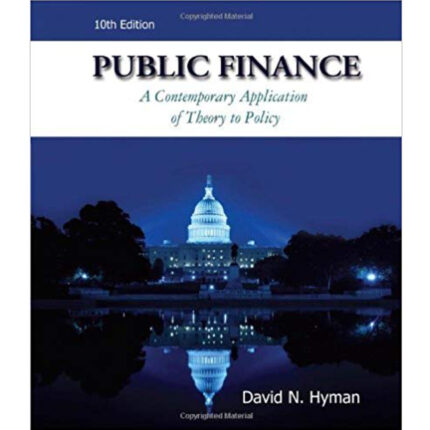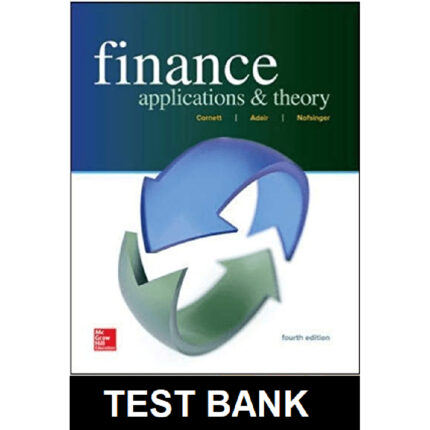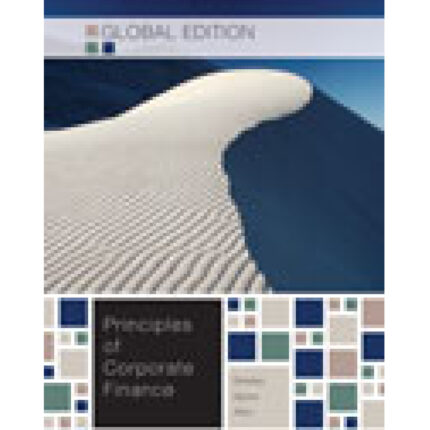Corporate Finance 11th Edition By Ross, Westerfield, Jaffe, Jordan – Test Bank
Chapter 11 Key
1. The expected return on a portfolio is best described as ____ average of the expected returns on the individual securities held in the portfolio.
A. an arithmetic
B. a weighted
C. a compounded
D. a geometric
E. a minimum
AACSB: Analytical Thinking
Accessibility: Keyboard Navigation
Blooms: Remember
Difficulty: 1 Basic
Ross – Chapter 11 #1
Section: 11.3
Topic: Portfolio return
2. Risk that affects a large number of assets, each to a greater or lesser degree, is called _____ risk.
A. idiosyncratic
B. diversifiable
C. systematic
D. asset-specific
E. total
AACSB: Analytical Thinking
Accessibility: Keyboard Navigation
Blooms: Remember
Difficulty: 1 Basic
Ross – Chapter 11 #2
Section: 11.6
Topic: Systematic and unsystematic risk
3. Risk that affects at most a small number of assets is called _____ risk.
A. portfolio
B. nondiversifiable
C. market
D. unsystematic
E. total
AACSB: Analytical Thinking
Accessibility: Keyboard Navigation
Blooms: Remember
Difficulty: 1 Basic
Ross – Chapter 11 #3
Topic: Systematic and unsystematic risk
4. The principle of diversification tells us that:
A. concentrating an investment in two or three large stocks will eliminate all of your risk.
B. concentrating an investment in three companies all within the same industry will greatly reduce your overall risk.
C. spreading an investment across five diverse companies will not lower your overall risk at all.
D. spreading an investment across many diverse assets will eliminate all of the risk.
E. spreading an investment across many diverse assets will eliminate idiosyncratic risk.
AACSB: Analytical Thinking
Accessibility: Keyboard Navigation
Blooms: Remember
Difficulty: 1 Basic
Ross – Chapter 11 #4
Topic: Diversification concepts and measures
5. The amount of systematic risk present in a particular risky asset, relative to the systematic risk present in an average risky asset, is called the particular asset’s:
A. beta coefficient.
B. reward-to-risk ratio.
C. total risk.
D. diversifiable risk.
E. Treynor index.
AACSB: Analytical Thinking
Accessibility: Keyboard Navigation
Blooms: Remember
Difficulty: 1 Basic
Ross – Chapter 11 #5
Section: 11.8
6. The linear relation between an asset’s expected return and its beta coefficient defines the:
A. reward-to-risk ratio.
B. covariance line.
C. characteristic line.
D. security market line.
E. market risk premium.
AACSB: Analytical Thinking
Accessibility: Keyboard Navigation
Blooms: Remember
Difficulty: 1 Basic
Ross – Chapter 11 #6
Section: 11.9
Topic: Security market line
7. The slope of an asset’s security market line is the:
A. reward-to-risk ratio.
B. portfolio weight.
C. beta coefficient.
D. risk-free interest rate.
E. market risk premium.
AACSB: Analytical Thinking
Accessibility: Keyboard Navigation
Blooms: Remember
Difficulty: 1 Basic
Ross – Chapter 11 #7
Section: 11.9
Topic: Security market line
8. You are considering purchasing stock S. This stock has an expected return of 12 percent if the economy booms, 8 percent if the economy is normal, and 3 percent if the economy goes into a recessionary period. The overall expected rate of return on this stock will:
A. be equal to one-half of 8 percent if there is a 50 percent chance of an economic boom.
B. vary inversely with the growth of the economy.
C. increase as the probability of a recession increases.
D. be independent of the probability of each economic state occurring.
E. increase as the probability of a boom economy increases.
AACSB: Analytical Thinking
Accessibility: Keyboard Navigation
Blooms: Understand
Difficulty: 2 Intermediate
Ross – Chapter 11 #8
Section: 11.2
Topic: Expected return
9. Which one of the following statements is correct concerning the expected rate of return on an individual stock given various states of the economy?
A. The expected return is a geometric average where the probabilities of the economic states are used as the exponential powers.
B. The expected return is an arithmetic average of the individual returns for each state of the economy.
C. The expected return is a weighted average where the probabilities of the economic states are used as the weights.
D. The expected return is equal to the summation of the values computed by dividing the expected return for each economic state by the probability of the state.
E. As long as the total probabilities of the economic states equal 100 percent, then the expected return on the stock is a geometric average of the expected returns for each economic state.
AACSB: Analytical Thinking
Accessibility: Keyboard Navigation
Blooms: Understand
Difficulty: 1 Basic
Ross – Chapter 11 #9
Section: 11.2
Topic: Expected return
10. The expected return on a stock that is computed using economic probabilities is:
A. guaranteed to equal the actual average return on the stock for the next five years.
B. guaranteed to be the minimal rate of return on the stock over the next two years.
C. guaranteed to equal the actual return for the immediate twelve month period.
D. a mathematical expectation based on a weighted average and not an actual anticipated outcome.
E. the actual return you will receive.













Reviews
There are no reviews yet.